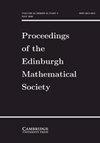Inequalities Concerning Maximum Modulus and Zeros of Random Entire Functions
IF 0.7
3区 数学
Q2 MATHEMATICS
Proceedings of the Edinburgh Mathematical Society
Pub Date : 2023-10-19
DOI:10.1017/s0013091523000639
引用次数: 2
Abstract
Abstract Let $f(z)=\sum\limits_{j=0}^{\infty} a_j z^j$ be a transcendental entire function and let $f_\omega(z)=\sum\limits_{j=0}^{\infty}\chi_j(\omega) a_j z^j$ be a random entire function, where $\chi_j(\omega)$ are independent and identically distributed random variables defined on a probability space $(\Omega, \mathcal{F}, \mu)$ . In this paper, we first define a family of random entire functions, which includes Gaussian, Rademacher and Steinhaus entire functions. We prove that, for almost all functions in the family and for any constant C > 1, there exist a constant $r_0=r_0(\omega)$ and a set $E\subset [e, \infty)$ of finite logarithmic measure such that, for $r \gt r_0$ and $r\notin E$ , \begin{equation*} |\log M(r, f)- N(r,0, f_\omega)|\le (C/A)^{\frac1{B}}\,\log^{\frac1{B}}\,\log M(r,f) +\log\,\log M(r, f), \qquad a.s. \end{equation*} where $A, B$ are constants, $M(r, f)$ is the maximum modulus and $N(r, 0, f)$ is the integrated zero-counting function of f . As a by-product of our main results, we prove Nevanlinna’s second main theorem for random entire functions. Thus, the characteristic function of almost all functions in the family is bounded above by an integrated counting function, rather than by two integrated counting functions as in the classical Nevanlinna theory. For instance, we show that, for almost all Gaussian entire functions f ω and for any ϵ > 0, there is r 0 such that, for $r \gt r_0$ , \begin{equation*} T(r, f) \le N(r,0, f_\omega)+\left(\tfrac12+\epsilon\right) \log T(r, f). \end{equation*}关于随机整函数的最大模和零的不等式
设$f(z)=\sum\limits_{j=0}^{\infty} a_j z^j$为超越整函数,$f_\omega(z)=\sum\limits_{j=0}^{\infty}\chi_j(\omega) a_j z^j$为随机整函数,其中$\chi_j(\omega)$为定义在概率空间$(\Omega, \mathcal{F}, \mu)$上的独立同分布随机变量。本文首先定义了一类随机整函数,其中包括高斯整函数、Rademacher整函数和Steinhaus整函数。我们证明了,对于几乎所有族中的函数和对于任意常数C >1、存在一个常数$r_0=r_0(\omega)$和一个有限对数测度集$E\subset [e, \infty)$,使得对于$r \gt r_0$和$r\notin E$, \begin{equation*} |\log M(r, f)- N(r,0, f_\omega)|\le (C/A)^{\frac1{B}}\,\log^{\frac1{B}}\,\log M(r,f) +\log\,\log M(r, f), \qquad a.s. \end{equation*}其中$A, B$为常数,$M(r, f)$为最大模量,$N(r, 0, f)$为f的积分计数函数。作为我们主要结果的副产品,我们证明了随机整函数的Nevanlinna第二主要定理。因此,族中几乎所有函数的特征函数都由一个积分计数函数限定,而不是像经典Nevanlinna理论那样由两个积分计数函数限定。例如,我们证明,对于几乎所有的高斯整函数f ω和任意的λ >0,有r 0,对于$r \gt r_0$, \begin{equation*} T(r, f) \le N(r,0, f_\omega)+\left(\tfrac12+\epsilon\right) \log T(r, f). \end{equation*}
本文章由计算机程序翻译,如有差异,请以英文原文为准。
求助全文
约1分钟内获得全文
求助全文
来源期刊
CiteScore
1.10
自引率
0.00%
发文量
49
审稿时长
6 months
期刊介绍:
The Edinburgh Mathematical Society was founded in 1883 and over the years, has evolved into the principal society for the promotion of mathematics research in Scotland. The Society has published its Proceedings since 1884. This journal contains research papers on topics in a broad range of pure and applied mathematics, together with a number of topical book reviews.

 求助内容:
求助内容: 应助结果提醒方式:
应助结果提醒方式:


